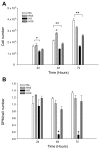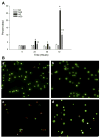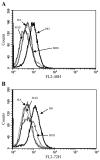Cyclic stretch attenuates effects of hyperoxia on cell proliferation and viability in human alveolar epithelial cells
- PMID: 16461433
- PMCID: PMC2683386
- DOI: 10.1152/ajplung.00160.2005
Cyclic stretch attenuates effects of hyperoxia on cell proliferation and viability in human alveolar epithelial cells
Abstract
The treatment of severe lung disease often requires the use of high concentrations of oxygen coupled with the need for assisted ventilation, potentially exposing the pulmonary epithelium to both reactive oxygen species and nonphysiological cyclic stretch. Whereas prolonged hyperoxia is known to cause increased cell injury, cyclic stretch may result in either cell proliferation or injury depending on the pattern and degree of exposure to mechanical deformation. How hyperoxia and cyclic stretch interact to affect the pulmonary epithelium in vitro has not been previously investigated. This study was performed using human alveolar epithelial A549 cells to explore the combined effects of cyclic stretch and hyperoxia on cell proliferation and viability. Under room air conditions, cyclic stretch did not alter cell viability at any time point and increased cell number after 48 h compared with unstretched controls. After exposure to prolonged hyperoxia, cell number and [(3)H]thymidine incorporation markedly decreased, whereas evidence of oxidative stress and nonapoptotic cell death increased. The combination of cyclic stretch with hyperoxia significantly mitigated the negative effects of prolonged hyperoxia alone on measures of cell proliferation and viability. In addition, cyclic stretch resulted in decreased levels of oxidative stress over time in hyperoxia-exposed cells. Our results suggest that cyclic stretch, as applied in this study, can minimize the detrimental effects of hyperoxia on alveolar epithelial A549 cells.
Figures








Similar articles
-
Hyperoxia alters the mechanical properties of alveolar epithelial cells.Am J Physiol Lung Cell Mol Physiol. 2012 Jun 15;302(12):L1235-41. doi: 10.1152/ajplung.00223.2011. Epub 2012 Mar 30. Am J Physiol Lung Cell Mol Physiol. 2012. PMID: 22467640 Free PMC article.
-
Preexposure to hyperoxia causes increased lung injury and epithelial apoptosis in mice ventilated with high tidal volumes.Am J Physiol Lung Cell Mol Physiol. 2010 Nov;299(5):L711-9. doi: 10.1152/ajplung.00072.2010. Epub 2010 Sep 10. Am J Physiol Lung Cell Mol Physiol. 2010. PMID: 20833778 Free PMC article.
-
Thioredoxin protects fetal type II epithelial cells from hyperoxia-induced injury.Pediatr Pulmonol. 2010 Dec;45(12):1192-200. doi: 10.1002/ppul.21307. Epub 2010 Sep 1. Pediatr Pulmonol. 2010. PMID: 20812253
-
Cyclic stretch-induced oxidative stress increases pulmonary alveolar epithelial permeability.Am J Respir Cell Mol Biol. 2013 Jul;49(1):156-64. doi: 10.1165/rcmb.2012-0252OC. Am J Respir Cell Mol Biol. 2013. PMID: 23526210 Free PMC article.
-
Alveolar cell death in hyperoxia-induced lung injury.Ann N Y Acad Sci. 2003 Dec;1010:405-16. doi: 10.1196/annals.1299.074. Ann N Y Acad Sci. 2003. PMID: 15033761 Review.
Cited by
-
A Macroscopic Diffusion-Based Gradient Generator to Establish Concentration Gradients of Soluble Molecules Within Hydrogel Scaffolds for Cell Culture.Front Chem. 2019 Sep 18;7:638. doi: 10.3389/fchem.2019.00638. eCollection 2019. Front Chem. 2019. PMID: 31620430 Free PMC article.
-
Mechanobiology in lung epithelial cells: measurements, perturbations, and responses.Compr Physiol. 2012 Jan;2(1):1-29. doi: 10.1002/cphy.c100090. Compr Physiol. 2012. PMID: 23728969 Free PMC article. Review.
-
Cyclic stretch magnitude and duration affect rat alveolar epithelial gene expression.Cell Physiol Biochem. 2010;25(1):113-22. doi: 10.1159/000272056. Epub 2009 Dec 22. Cell Physiol Biochem. 2010. PMID: 20054150 Free PMC article.
-
The function role of ubiquitin proteasome pathway in the ER stress-induced AECII apoptosis during hyperoxia exposure.BMC Pulm Med. 2021 Nov 22;21(1):379. doi: 10.1186/s12890-021-01751-9. BMC Pulm Med. 2021. PMID: 34809635 Free PMC article.
-
Prolonged mechanical ventilation induces cell cycle arrest in newborn rat lung.PLoS One. 2011 Feb 16;6(2):e16910. doi: 10.1371/journal.pone.0016910. PLoS One. 2011. PMID: 21359218 Free PMC article.
References
-
- Allen RG, Tresini M. Oxidative stress and gene regulation. Free Radic Biol Med. 2000;28:463–499. - PubMed
-
- Cavanaugh KJ, Jr, Margulies SS. Measurement of stretch-induced loss of alveolar epithelial barrier integrity with a novel in vitro method. Am J Physiol Cell Physiol. 2002;283:C1801–C1808. - PubMed
-
- Chang L, Karin M. Mammalian MAP kinase signalling cascades. Nature. 2001;410:37–40. - PubMed
-
- Chess PR, Toia L, Finkelstein JN. Mechanical strain-induced proliferation and signaling in pulmonary epithelial H441 cells. Am J Physiol Lung Cell Mol Physiol. 2000;279:L43–L51. - PubMed
-
- Dos Santos CC, Slutsky AS. Mechanisms of ventilator-induced lung injury: a perspective. J Appl Physiol. 2000;89:1645–1655. - PubMed
MeSH terms
Substances
Grants and funding
LinkOut - more resources
Full Text Sources

